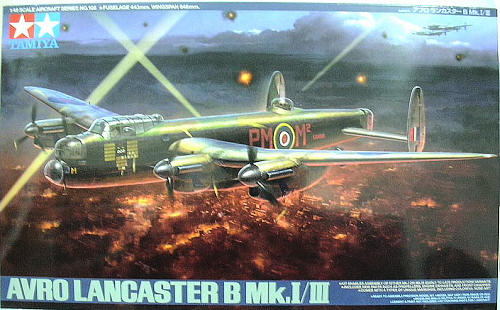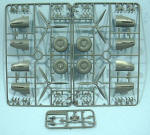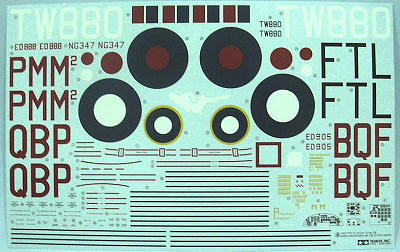
Tamiya 1/48 Lancaster B.I/III
| KIT #: | 61105 |
| PRICE: | 6400 yen from www.hlj.com |
| DECALS: | Four options |
| REVIEWER: | Tom Cleaver |
| NOTES: | Upgraded kit. |

| HISTORY |
The Lancaster was the most successful British four-engined
heavy bomber of the war, and ultimately became the backbone of Bomber Command.
Developed from the twin-engine Manchester which was a
failure due to its Vulture engines, the Lancaster was an inspired design that
earned the loyalty and love of its crews.
The Lancaster came in three versions: the Merlin-powered
B.Mk.I and B.Mk.III were differentiated by the fact that the Mk.I used the
British-produced Merlin, while the Mk.III used American Packard-Merlins;
otherwise the two were indistinguishable and no airframe in production was
listed as one or the other until it received its engines.
The B.Mk.II was powered by Bristol Hercules radials, and
was produced to insure availability if there were insufficient Merlins produced.
The B.Mk.I(FE) was original developed to be used by Tiger Force, the proposed RAF strategic bombing force that would join the Americans in the Pacific for the assault on Japan. The Lancaster was originally not planned for this force, but when development and production difficulties hit the Lincoln, the Lancaster was pressed into service with additional internal tankage and a plan for in-flight refueling to enable the aircraft to operate from the Marianas. Approximately 200 B.Mk.Is were modified to the F.E. standard, and were operated post-war by squadrons in the Middle East and the Far East, where they took part in the initial aerial operations of the Malayan Insurgency campaign.
| THE KIT |
 Tamiya first brought out their 1/48 Lancaster in 1972,
and it has been in production off and on ever since.
The kit has some minor accuracy glitches, but in its
original form it mostly made up into an accurate B.Mk.III.
It was also released as a Lancaster used in the Dams
Raid with the spinning mine, and as a late-war Lancaster armed with the
incredible 20,000-lb “Tallboy” bomb.
Tamiya first brought out their 1/48 Lancaster in 1972,
and it has been in production off and on ever since.
The kit has some minor accuracy glitches, but in its
original form it mostly made up into an accurate B.Mk.III.
It was also released as a Lancaster used in the Dams
Raid with the spinning mine, and as a late-war Lancaster armed with the
incredible 20,000-lb “Tallboy” bomb.
Over the years, modelers have complained that the kit
did not provide the narrow-chord props associated with the Mk.I, though
modifying the kit props was a simple process using a sanding stick and perhaps
30-40 minutes of one’s time.
A more cogent complaint was that the engine cowls fit
the nacelles badly, requiring lots of putty, sanding, and rescribing to get them
looking right.
 Tamiya
appears to have gotten the message.
This kit provides both types of propellers, and the
engine cowlings have been redesigned so that their fit is excellent.
The kit includes extra cowlings that do not have the
flame damping covers, and individual exhaust stacks.
It also includes the two la
Tamiya
appears to have gotten the message.
This kit provides both types of propellers, and the
engine cowlings have been redesigned so that their fit is excellent.
The kit includes extra cowlings that do not have the
flame damping covers, and individual exhaust stacks.
It also includes the two la te-war
bulged bomb-aimer’s “bubble,” and the modified FN50 turret equipped with two
U.S. M-2 .50 caliber machine guns that appeared on Lancasters during the last
year of the war.
Additionally, the kit is molded in overall grey plastic, which
makes assembly and painting much easier.
Additionally, the kit includes a set of “weighted” main
wheels.
te-war
bulged bomb-aimer’s “bubble,” and the modified FN50 turret equipped with two
U.S. M-2 .50 caliber machine guns that appeared on Lancasters during the last
year of the war.
Additionally, the kit is molded in overall grey plastic, which
makes assembly and painting much easier.
Additionally, the kit includes a set of “weighted” main
wheels.
Decals are provided for three Second World War bombers, two Mk.IIIs that were not equipped with the ubiquitous H2S radome under the rear fuselage, and a B.Mk.I which was so equipped. The fourth possibility is a B.Mk.I(FE) operated by No.35 Squadron, which made a tour of North America in 1947 and was later operated in the Far East and Middle East until the early 1950s. These decals, unlike those for the earlier releases, are the right colors and look very accurate overall.
| CONCLUSIONS |
A good kit has just gotten better, and at a price of
6400 Yen it is a bargain to boot.
The Lancaster makes up into a very impressive model that
will dominate any collection by its sheer size.
Don’t let the “raised line detail” put you off - this
results in a far more accurate-looking model when completed than would “state of
the art” engraved detail.
Also, do not let the size put you off - the kit is
well-designed and any modeler of average abilities should have no problem
creating a model they will consider the jewel of their collection.
Review kit courtesy HobbyLink Japan. Get yours at www.hlj.com
If you would like your product reviewed fairly and quickly, please contact me or see other details in the Note to Contributors.